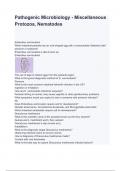Biologen Study guides, Class notes & Summaries
Looking for the best study guides, study notes and summaries about Biologen? On this page you'll find 298 study documents about Biologen.
Page 4 out of 298 results
Sort by
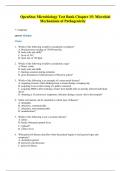
-
OpenStax Microbiology Test Bank Chapter 15: Microbial Mechanisms of Pathogenicity
- Exam (elaborations) • 16 pages • 2024
- Available in package deal
-
- $13.00
- + learn more
OpenStax Microbiology Test Bank Chapter 15: Microbial Mechanisms of Pathogenicity * = Correct answer Multiple Choice 1. Which of the following would be considered a symptom? A. blood pressure reading of 150/90 mm Hg B. body ache and chills* C. fever of 39 C D. heart rate of 120 bpm 2. Which of the following would be considered a sign? A. blurry vision B. body ache and chills C. burning sensation during urination D. gross hematuria (visible presence of blood in urine)* 3. W...
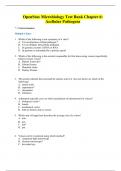
-
OpenStax Microbiology Test Bank Chapter 6: Acellular Pathogens
- Exam (elaborations) • 14 pages • 2024
- Available in package deal
-
- $16.50
- + learn more
OpenStax Microbiology Test Bank Chapter 6: Acellular Pathogens * = Correct answer Multiple Choice 1. Which of the following is not a property of a virus? A. It is an infectious cellular pathogen.* B. It is an obligate intracellular pathogen. C. Its genome consists of DNA or RNA. D. Its genome is surrounded by a protein capsid. 2. Which of the following is the scientist responsible for first discovering viruses (specifically, tobacco mosaic virus)? A. Dimitri Ivanovski* B. Edward Jen...
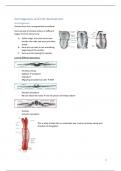
-
Samenvatting H9: Somitogenesis and Limb development - Prezmko - Developmental Biology
- Summary • 20 pages • 2023
- Available in package deal
-
- $7.23
- + learn more
Volledige samenvatting H9: Somitogenesis and Limb development - Developmental Biology
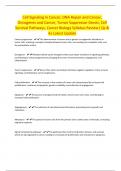
-
Cell Signaling in Cancer, DNA Repair and Cancer, Oncogenes and Cancer, Tumor Suppressor Genes, Cell Survival Pathways, Cancer Biology Syllabus Review| Qs & As Latest Update
- Exam (elaborations) • 11 pages • 2024
-
- $13.49
- + learn more
Cancer progression - The advancement of cancer due to genetic or epigenetic alterations in tumor cells, involving a complex interplay between tumor cells, surrounding non-neoplastic cells, and the extracellular matrix. Oncogenes - Mutated cellular proto-oncogenes that cause hyper-activation of signaling pathways, contributing to cancer progression by changing the tumor microenvironment, angiogenesis, and inflammation. Tumor suppressors - Genes that, when inactivated, eliminate negative reg...
Pathogenic Microbiology - Miscellaneous Protozoa, Nematodes

-
Microbiology- Viruses, Disease and Epidemiology, Pathogenicity and Virulence, Immunity Review Questions and Answers
- Exam (elaborations) • 24 pages • 2024
- Available in package deal
-
- $10.49
- + learn more
Are Viruses Living or Nonliving? They are only considered living when they are inside of a host cell, using their resources and energy. Outside of a host they are considered intert. When are Viruses considered to be "alive"? When they are inside of a host cell. When inside, their nucleic acid (ONLY RNA OR DNA) become active. *Virus replicates Obligatory Intracellular Parasites Require livinghost cell in order to multiply - Such as Viruses. Defining a Virus 1) Contains 1 Nucleic Aci...
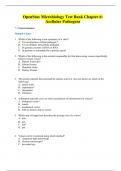
-
OpenStax Microbiology Test Bank Chapter 6: Acellular Pathogens
- Exam (elaborations) • 14 pages • 2024
-
- $16.79
- + learn more
OpenStax Microbiology Test Bank Chapter 6: Acellular Pathogens * = Correct answer Multiple Choice 1. Which of the following is not a property of a virus? A. It is an infectious cellular pathogen.* B. It is an obligate intracellular pathogen. C. Its genome consists of DNA or RNA. D. Its genome is surrounded by a protein capsid. 2. Which of the following is the scientist responsible for first discovering viruses (specifically, tobacco mosaic virus)? A. Dimitri Ivanovski* B. Edward Jen...
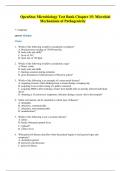
-
OpenStax Microbiology Test Bank Chapter 15: Microbial Mechanisms of Pathogenicity
- Exam (elaborations) • 16 pages • 2024
-
- $17.39
- + learn more
OpenStax Microbiology Test Bank Chapter 15: Microbial Mechanisms of Pathogenicity * = Correct answer Multiple Choice 1. Which of the following would be considered a symptom? A. blood pressure reading of 150/90 mm Hg B. body ache and chills* C. fever of 39 C D. heart rate of 120 bpm 2. Which of the following would be considered a sign? A. blurry vision B. body ache and chills C. burning sensation during urination D. gross hematuria (visible presence of blood in urine)* 3. W...
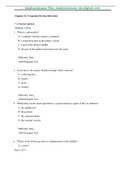
-
OpenStax Microbiology Test Bank Chapter 23: Urogenital System | Complete & Graded A+
- Exam (elaborations) • 29 pages • 2022
-
- $12.99
- + learn more
OpenStax Microbiology Test Bank Chapter 23: Urogenital System | Complete & Graded A+ OpenStax Microbiology Test Bank Chapter 23: Urogenital System * = Correct answer Multiple Choice 1. What is a glomerulus? A. a capillary bed that contacts a nephron* B. a connecting duct in the urinary system C. a part of the urinary bladder D. the part of the nephron that drains into the ureter Difficulty: Easy ASM Standard: N/A 2. Urine leaves the urinary bladder through which structure? A. collecting duct B. ...
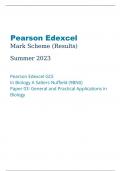
-
Pearson Edexcel Level 3 GCE Biology A Advanced PAPER 3 General and Practical Applications in Biology together with marking scheme June 2023
- Package deal • 2 items • 2023
-
- $27.49
- + learn more
Pearson Edexcel Level 3 GCE Biology A Advanced PAPER 3 General and Practical Applications in Biology together with marking scheme June 2023

How much did you already spend on Stuvia? Imagine there are plenty more of you out there paying for study notes, but this time YOU are the seller. Ka-ching! Discover all about earning on Stuvia

